September 25th-26th
For my first unit of my second year HND course I have been set the brief of “Political, Digital, Truth.”
This means my work for this brief needs to be Political, play with Digital manipulation and needs to challenge the notion of Truth in photography.
My starting point begins with researching into broadsheet newspapers looking at social and political press stories as a catalyst to create a theme, a piece that ties into the news current affairs which is controversial and plays on the truth via digital manipulation. This means the article I decide on needs to be a topic I can look at in-depth, potentially with a wide network of causal links.
My Initial newspaper collated research spans from looking at Ebola, the Alice Gross disappearance-now murder case, Sexual Predator cases including the current celebrity sex scandals that have come out since the Saville case the other year and the terrorist movement in Syria and Iraq, known as ISIS.
I intend on expanding this information into various different news sources before narrowing down my findings into one particular topic.
October 1st-3rd
Over the previous week I have collated various news stories from various news sources, and narrowed my findings down firstly to a particular topic, that had a wide variety of news stories from different perspectives and political standings (utilising www.newsworks.org.uk to research demographics), this being the new war in Iraq against the terrorist movement that is referred to by the Western media as “ISIS”. A lot of the articles ran an underlying theme, primarily references to the lack of Syrian war relief action last year and also the crux of the previous Iraq wars, with the Western World changing sides as often as they change underwear (including an interesting notion ISIS itself was initially created by the CIA). The second underlying theme revolves around Saudi Arabia and the Western World supporting them even though they fund terrorist organisations with money made from sales of their oil.
“For the last half century, Britain’s strategy in the Middle East has been dominated by our friendship with Saudi Arabia and its neighbouring states. For the last few decades, this alliance has grown steadily more perilous as Saudi Arabia, in order to ensure its domestic stability, exports its extremist Wahhabi teaching abroad.
Hence bin Laden and 9/11. hence Baghdadi and his Islamic state. Militant jihadist terrorism is a Saudi creation. Successive governments have refused to recognise this. Instead adhering to a system of alliances that has ended up posing the terrible threat to our security that we are experiencing.”
Extract from ‘Bombing plays into the hands of Saudi-inspired militant jihadists’
Writer: Peter Oborne
Daily Telegraph, 25th September, 2014
Headlines of articles I looked into regarding ISIS/ Terrorist Organisations, the Middle East and Oil:
- Daily Mail, September 22nd – Shell Steps Up Oil Theft Battle – Unattributed
- Daily Mail, September 24th – Mum sends her children to school with ‘halal only’ badges – Chris Brooke
- Daily Mail, September 24th – Israelis Kill Hamas Kidnap Suspects – Unattributed
- Daily Mail, September 24th – MPs must learn from past mistakes on Iraq – Unattributed- Daily Mail Comment
- Daily Mail September 24th – US strikes to avert another 9/11 – Vanessa Allen
- Daily Mail September 24th – Agony of Hostage’s Wife As He Begs For His Life – Vanessa Allen
- Daily Mail September 24th – No Return to UK for freed Abu Qatada, vows May – Josh Halliday; Alan Travis; Alice Su
- Daily Mail September 24th – This could be Obama’s Vietnam, warns hostage – David Williams
- Daily Mail September 24th – Five Arab States join in aerial offensive – David Williams
- Daily Mail September 24th – RAF jets could be bombing jihadis by the weekend – Jason Groves
- Daily Mail September 24th – Why the old enemy Iran is suddenly a crucial ally – Michael Burleigh
- Daily Telegraph September 25th – One in four Britons fears terrorist attack – Unattributed
- Daily Telegraph September 25th – Boko Haram will swap girls for prisoners – Colin Freeman
- Daily Telegraph September 25th – Shia rebels force way into Yemen government – David Blair
- Daily Telegraph September 25th – Obama asks world to unite behind his mission to blitz Isil – Phillip Sherwell
- Daily Telegraph September 25th – Bombing plays into the hands of Saudi-inspired militant jihadists – Peter Oborne
- Daily Telegraph September 25th – Qatada cleared by Jordan court but will not be allowed back to UK – David Barrett, Ruth Sherlock and Linda al-Maayeh
- Daily Telegraph September 25th – Shia rebels force way into Yemen government – David Blair
- The Independent September 25th – Briton ‘used carbon trading to fund terror’ – Michael Day and Tom Bawden
- The Independent September 25th – ‘We must deal with these psychopathic murderers’ – Peter Dominiczak
- The Independent September 25th – Public mood shifts towards military action – Nigel Morris
- The Independent September 25th – View from Jordan, A temporary strategy of divide and rule – Peter Beaumont
- The Independent September 25th – We must play our part, The US is taking the fight to Isis, and so – if key conditions are met – should the UK – Editorials
- The Independent September 25th – Bombs alone will not defeat an enemy that knows how to melt away – Patrick Cockburn
- The Independent September 25th -Brighton jihadi killed in Syria drone strike – Ian Johnston
- The Independent September 25th – As a matter of law, we do not need the UN’s permission to attack these criminals – Geofrey Robertson
- The Independent September 25th – Abu Qatada cleared but cannot return to UK – Jamie Grierson
- The Independent September 25th – Radicalised Muslims in UK more likely to be well-heeled – Emily Dugan
- The Independent September 25th – US air strikes are failing to slow ISIS, say desperate Kurds – Isabel Hunter
- The Guardian September 25th – Alan Henning, Hostage’s family changes tack after brutal exposure – Helen Pidd
- The Guardian September 25th – Algerian Kidnapping, Hollande confirms beheading of French citizen – Chris Johnston; Kim Willsher
- The Guardian September 25th – Isis hijacks Twitter hashtags to spread extremist message – Shiv Malik; Sandra Laville; Elena Cresci; Aisha Gani
- The Guardian September 25th – Obama tells Islamic State: get out of the way while you can – Julian Borger; Patrick Wintour
- The Guardian September 25th – Jihadi from Brighton ‘died in air strikes’ – Shiv Malik; Karen McVeigh; Elena Cresci; Aisha Gani
- The Guardian September 25th – Journal; Secularism A violent history – Karen Armstrong
- The i newspaper September 26th – Hamas and Fatah reach Gaza unity agreement – Reuters
- The i newspaper September 26th – Ukraine gas supplies suspended after threat – AFP
- The i newspaper September 26th – Eradicate Isis, urges UK victim’s daughter – Ian Johnston
- The i newspaper September 26th – Azerbaijan in oil production pledge – Unattributed
- The Independent September 26th – PM urged to intervene after British man is shot on death row in Pakistan – Andrew Buncombe and Jonathan Brown
- The Independent September 26th – Qatar’s women’s basketball team quits in hijab row – Peter Popham
- The Independent September 26th – Civilians ‘afraid to leave house’ amid bomb fears – Isabel Hunter
- The Independent September 26th – Abba’s unity government to rule in Strip – Shadi Bushra
- The Independent September 26th – Silence the fanatics – Unattributed
- The Independent September 26th – Segregation demands delay transatlantic flight – AFP
- The Independent September 26th – Hostage’s daughter calls for military action – Ian Johnston and Cahal Milmo
- The Independent September 26th – Third Iraq war to start within days – Unattributed
- The Independent September 26th – This looks more like Cameron’s Libya disaster than Blair’s Iraq – Patrick Cockburn
- The Independent September 26th – France and US on alert as Iraq warns of Isis threat to metros – John Lichfield
- The Independent September 26th – Choudary arrest part of attempt to disrupt Britain’s radical Muslims- Paul Peachey
- The Independent September 26th – US military chief warns of long road ahead – Missy Ryan
- The Independent September 26th – Separatist war is winding down, says President – Richard Balmsforth
- The Independent September 26th – Turkey we need you – Unattributed
- The Independent September 26th – UK poised to begin bombing Isis in conflict that will last for years- Andrew Grice
- The Independent September 26th – Timeline ‘United Against ISIS’ – Unattributed
- The Independent September 26th – FBI identifies masked British killer – David Osborne
- The Independent September 26th – Our special forces may be vital in this new Iraq War – Kim Sengupta
- The Independent September 26th – MPs will back air strikes, but Fallon warns that war could last for years – Andrew Grice
- The Independent September 26th – Anjem Choudary among nine held for supporting banned terrorist group – Paul Peachey
- The Independent September 26th – As the US missiles rain down, the only constant is the flood of refugees – Isabel Hunter
- The Independent September 26th – On the eve of yet another war in Iraq, is the UK’s strategy any more coherent than in 2003? – Patrick Cockburn
- The Independent September 26th – Letters to the Editor – Various
- Daily Mail September 26th – Our RAF pilots must dread falling into ISIS hands…it would be far more terrifying than my own capture – John Nichol
- Daily Mail September 26th – Six RAF Tornados will lead the blitz – David Williams and Ian Drury
- Daily Mail September 26th – Three-Year War to Crush Jihadis – James Chapman, David Williams and Tamara Cohen
- Daily Mail September 26th – Train bomb plot to hit U.S. and France – David Williams
- Daily Mail September 26th – You’ve just been bombed…by a woman – David Williams
- Daily Mail September 26th – Fanatics killed my dad…we must hit back – Laura Cotton
- Daily Mail September 26th – We’ve got an ID for Jihadi John, claims the FBI – Unattributed
- Daily Mail September 26th – Muslim firebrand is arrested as police hold nine rabble-rousers – Chris Greenwood, Neil Sears and Slan Boyle
- Daily Mail September 26th – Cheeky pupil who turned jihadi and died in blitz – Eleanor Harding and Sam Greenhill
- Daily Mail September 26th – Hate-filled words of self-styled sheikh – Vanessa Allen
- Daily Mail September 26th – Father of three who praised 7/7 bombers – Daily Mail Reporter
- Daily Mail September 27th – Bewildered fury of the Brighton mum whose teenage son ran off to become a jihadi – David Jones
- Daily Mail September 27th – Britain buys 20 Tomahawk missiles ready to strike IS – David Williams and Ian Drury
- Daily Mail September 27th – Why, with heavy heart, I believe we have no choice but to go to war again – Max Hastings
- Daily Mail September 27th – RAF jets to pound IS forces today – James Chapman, Jason Groves and Tamara Cohen
- Daily Mail September 27th – Miliband risks ‘playing into Putin’s hands’ – Jason Groves
- Daily Mail September 27th – Talk was of Dark Ages, barbarity…a Satanic enemy – Quentin Letts
- Daily Mail September 27th – Air Strikes are right thing to do, says Welby – Unattributed
- The Guardian September 27th – Bombing to start in hours as MPs back new Iraq war – Patrick Wintour
- The Guardian September 27th – We must beware-Isis wants the west to wage a crusade – Oliver Miles
- The Guardian September 27th – ‘Children’s intifada’ under way as tensions rise in Jerusalem – Peter Beaumont
- The Guardian September 27th – Education can inoculate young Muslims against radicalism – Giles Fraser
- The Guardian September 27th – Family’s plea over man shot in Pakistan jail – Libby Brooks
- The Guardian September 27th – Afghanistan’s new leader puts theories to test – Emma Graham-Harrison
- The Guardian September 27th – Kurds on the front line are living in fear of Turkish stab in the back – Constanze Letsch
- The Guardian September 27th – Price of beating Isis could be high – Simon Tisdall
- The Financial Times September 29th – US poised to become world’s leading liquid petroleum producer – Ed Crooks and Anjli Raval
P.S. Although not part of my original collated news stories, The International Business Times on Oct 16th have written a piece which speculates the drop in current oil prices will in the long term hinder ISIS and the amount of control they’ll have in the Middle East: http://www.ibtimes.com/how-saudi-arabian-oil-could-hurt-isis-finances-iraq-syria-1706423
I also looked into an August 2014 interview of Antonia Juhasz author of “The Tyranny of Oil”, which implies that all action taken in the Middle East in recent years is purely due to oil http://consortiumnews.com/2014/08/17/iraq-and-the-oil-wars/
And as of November 1st it has been declared that ISIS itself, is advertising for an oil plant manager: ‘Daily Mail 1st November- ISIS advertise’ and ‘Metro November 1st – ISIS are advertising’ both report that ISIS are likely in trouble as they can no longer threaten the existing workers and are looking for new ones.
October 8th-10th

Banksy in Westwood, Los Angeles, CA Feb 18 2011 by Karri Allrich
Over the course of this week I’ve continued with research- primarily artist research, starting off by looking at guerilla graffiti artists, such as Banksy (in particular his piece, The Crayon Shooter, 2011.) In this piece Banksy juxtaposes guns and warfare with children involved in modern wars, by depicting a child dressed like a soldier holding an assault rifle- the only elements of colour in the piece are the replaced elements of ammunition, depicted instead as children’s crayons, with childlike doodles etched around the boy, and comments politically on the fact children are getting dragged into war and having to put away their childhood before they have really grown up.
I researched into staged and re-staged war photography from contemporary fine art photographers such as An-My Lê, Mitchell Wilston and Jennifer Karady whose work utilises symbolism and re-enactment to narrate their images- in the case of Karady working with the veteran soldiers to recreate a chosen moment from their memories of war. And on the other hand when is a photo no longer the truth- looking into the controversy around Stepan Rudik’s entry for the World Press Photo contest, as well as Ruben Salvadori’s documentary video which showcases how photojournalist’s themselves in war-zones manipulate and influence events around them to gain the shots they are after. I also looked into historical political photos which have been doctored, edited, with the earliest known case being circa 1860 of Abraham Lincoln where his head has been superimposed on a Southern politician, John Calhoun’s body, you can view a historical list (although US biased it is interesting read) here.
I also revisited my previous photography course note’s on Appropriation Art (such as controversial appropriation artists such as Richard Prince, Sherrie Levine and Thomas Ruff) and Cinemagraphs (looking at artists such as Jamie Beck and Kevin Burg, one of the pioneers behind the process).
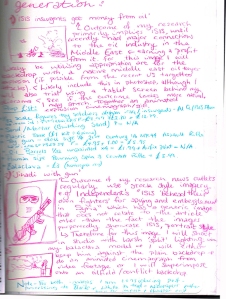
Final Idea Generation (Scanned from Sketchbook)
I’m beginning to finalise my ideas for my test shoot and final shoot.
October 16th-18th
Image right, is a scan from my sketchbook, which showcases my thought process for my final idea generation- I intend on producing images using 1/32 miniatures in a diorama scene to convey the correlation between ISIS and the oil industry, and creating a generic jihadi portrait. For both ideas I will be attempting to include Appropriated backgrounds or backdrops as well as utilising video footage and various similar stills to create cinemagraph imagery.
Idea 1)‘ISIS Insurgents get money from oil’ – Using 1/32 scale toy Afghan/Iraq insurgents posed in landscape scenes for example with a mosque or surrounded by oil drums and military hardware, e.g. a tank, against an appropriated background showing a distant explosion and/or oil wells on fire to mislead the viewer to believe that the scene is a real event.
Connotation: With the ISIS Insurgents against an archetypal Middle East conflict setting in the background it mimics a typical news editorial composition, implying that the ISIS Insurgents are driven by a desire to control the oil supply to the West
Denotation: The Insurgents composed with oil drums with a Middle East conflict setting in the background.
Idea 2)‘Jihadi with gun’ – A human male model dressed like an ISIS fighter in black with a covered head e.g. using a balaclava, posing with a gun or assault rifle/machine gun set against an appropriated background showing a distant explosion and/or oil wells on fire to mislead the viewer to believe that the scene is a real event.
Connotation: With the ISIS fighter in a threatening pose brandishing a gun/rifle, it communicates a sinister propaganda message to the viewer. The viewer will feel that they are under fire themselves
Denotation: A model dressed as an ISIS fighter with a conflict explosion or oil wells on fire in the background
Props List:
- an appropriated image, copyright free or under Creative Commons
- baking tray to hold sand for my miniature diorama
- a baking tray to hold sand for my miniature diorama
- a portable tablet computer screen to use as a appropriated backdrop
- building sand or mortar to use as a landscape
- 1/32 scale Islamic insurgent figurines and oil drums, model paints
- clothing e.g. a balaclava, and semi-realistic military weapons e.g. guns, scale model toy tank etc.
![Miniature Insurgents Lighting Diagram Miniature Insurgents [ISIS] Diorama [Olympus 60mm Macro 2.8] Flash@ 1/125 ISO200 F/22 [STILLS] Continuous@ 1/80 ISO1600 F/16 [Tablet Screen Backdrop]](https://jasmineameliamurrayphotography.files.wordpress.com/2014/09/lighting-diagram-1413904851-e1413904848453.png?w=285&h=300)
Miniature Insurgents [ISIS] Diorama Lighting Diagram [Olympus 60mm Macro 2.8]
Flash@ 1/125 ISO200 F/22 [Stills]
Continuous@ 1/80 ISO1600 F/16 [Tablet Screen Backdrop]
(Lighting diagrams made using: http://www.lightingdiagrams.com/Creator)
For my Miniature Insurgents Imagery, I utilised a lighting table (in white)- which I lit from behind and below to gain a pure white backdrop for my miniature pieces. The actual diorama pieces are lit by soft-boxes at equal power, equal distance left and right of the objects to gain uniform soft lighting, with no harsh shadows. I initially shot each 1/32 scale piece by itself, before building my diorama scene using Building Sand/Mortar/Sand spread out in mounds on a baking tray with each 1/32 pieces’ bases being slightly submerged in the sand for a realistic desert scene. Like the initial pieces I shot the diorama from various different angles at 1/125, F/22, ISO 200. After I shot from various angles I changed from using Flash lighting to shooting with a Continuous Bulb (as the Continuous Bulb is Tungsten the images came out with a warmer hue), so I could also include a Tablet Screen with Appropriated Desert Scene as the backdrop, without having weird reflections from the flash.
![Jihadist Bomber Portrait Lighting Diagram Flash@ 1/125 ISO200 F/22 [Stills] Continuous@ 1/80 ISO1600 F/16 [Video Footage]](https://jasmineameliamurrayphotography.files.wordpress.com/2014/09/lighting-diagram-1413903362-e1413903955286.png?w=300&h=232)
Jihadist Bomber Portrait Lighting Diagram [Olympus 45mm 1.8]
Flash@ 1/125 ISO200 F/22 [Stills]
Continuous@ 1/80 ISO1600 F/16 [Video Footage]
For my generic Jihadist Bomber Portrait I used an IKEA roller-blind in white, I had two soft-boxes with equal power, distance and angles between (on the left and the right) pointing at the blind measured at f/45 to produce a pure white uniform backdrop. My model was lit with a harsh spotlight on the left at the model’s head level to create split lighting, half of the face in the light and the other half in the shadow. I utilised the following props: a motorcycle balaclava and a large child’s toy ‘assault rifle’ gun. I shot the model in various poses with the gun including lifting the balaclava to turn it into a makeshift turban. After my initial still shots I switched to continuous lighting only for my video footage which had my model holding as still as possible with the toy gun feeding ammunition in and a shooting action, all this was shot at 1/80, F/16, ISO 1600.
Editing Processes:
PA110692.MOV ‘Jihadist Bomber’
1) File> Import> Video Frames to Layers -> select area of video. Tick make Frame Animation
2) In this instance= 200 layers for gif series for clean smooth animation
3) Hue/Saturation slight desaturation of yellow hues (sourced from the tungsten continuous lights)
4) Convert to Black and White- red channel
5) Layer Mask> remove logo on end of gun
6) Save for web> gif and optimise for web by reducing size/colour restriction
7) Also saved as a still on the blurred animation shot in .jpg format
Depicts jihadist dressed in a Balaclava, wearing all black, holding an toy assault rifle – blurred in motion to look as though he is firing the gun. I wanted to depict an archetypal stereotypical jihad, to mimic The Independent’s article (Thursday 16th October) “ISIS ‘behead their own fighters’ for spying and embezzlement in Syria” which uses images that seem to be stock-like in nature and don’t particularly narrate the story being written other than the fact the people depicted are flying the ISIS’ black flag. This implies that journalists often warp the truth by using imagery that has nothing to do with the story at hand, sensationalism, or is a completely staged story, for example Daily Mirror’s 2004 Iraq Beheadings (The ‘torture’ photos that hoaxed the Mirror – The Guardian, 21 May 2004: http://www.theguardian.com/gall/0,,1208623,00.html)- which utilises completely staged imagery as well as a fake story. However I feel the human jihadist with gun series doesn’t have the correct impact I am looking for, as the gun looks fake, more like a SAS gun than one used by insurgents, and as such I feel these images will not fool the viewer into thinking the scene in front of them is a ‘very real’ shot of a jihadist rebel with a gun. This is furthered in this image by the lack of desert background. I chose to also depict my jihad as a cinemagraph, a homage to the future of journalism- as cinemagraphs are more than a picture, but not quite a video. The main goal of cinemagraphs are to illustrate a short story and a prime example of this is the “magical newspapers” in Harry Potter. In this instance to depict the fact that jihads as reported in western media are rather trigger happy, willing to kill anybody who stands in their path.
PA110693.ORF
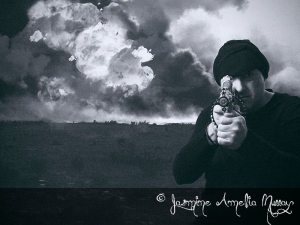
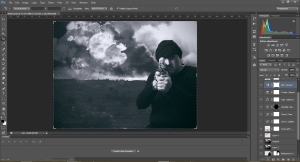 PA110693.ORF and Screengrab ‘Jihadist Bomber’
PA110693.ORF and Screengrab ‘Jihadist Bomber’
1) Rotate canvas to landscape, but keep subject portrait- move to far right so subject sits on 1/3
2) Layer mask extract model from backdrop
3) Paste in explosion layer underneath and apply a slight gaussian blur/tilt shift to the image.
4) New Layer inverse elliptical selection, and apply a 15% opacity vignette gradient
5) Area Lighten 10% opacity upper left (below vignette layer)
-Curve Lighten and Tone Adjust> Colour Balance> Desaturate
slightly and Contrast-> Adjust red tones
6) Convert to Black and White> Red filter high contrast
7) Add Noise “Mock Film Grain” at 10% opacity for textured finish
Depicts jihadist dressed in a Balaclava, wearing all black, holding an toy assault rifle – blurred in motion to look as though he is firing the gun. I wanted to depict an archetypal stereotypical jihad, to mimic The Independent’s article (Thursday 16th October) “ISIS ‘behead their own fighters’ for spying and embezzlement in Syria” which uses images that seem to be stock-like in nature and don’t particularly narrate the story being written other than the fact the people depicted are flying the ISIS’ black flag. This implies that journalists often warp the truth by using imagery that has nothing to do with the story at hand, sensationalism, or is a completely staged story, for example Daily Mirror’s 2004 Iraq Beheadings (The ‘torture’ photos that hoaxed the Mirror – The Guardian, 21 May 2004: http://www.theguardian.com/gall/0,,1208623,00.html)- which utilises completely staged imagery as well as a fake story. However I feel the human jihadist with gun series doesn’t have the correct impact I am looking for, as the gun looks fake, more like a SAS gun than one used by insurgents, and as such I feel these images will not fool the viewer into thinking the scene in front of them is a ‘very real’ shot of a jihadist rebel with a gun, even with an additional photoshopped backdrop, it still feels as though he is not on scene/ staged.
The actual backdrop in this instance is “Burning oilfield during Operation Desert Storm, Kuwait” purportedly by Jonas Jordan, United States Army Corps of Engineers (Source: http://en.wikipedia.org/wiki/File:Kuwait_burn_oilfield.png, Public Domain Licensing) and actually showcases the 1991 oil fires in Kuwait and not current war events (although the US are using air strikes to bomb oil fields in Iraq).
PA110714.ORF [1/2 Selected Final Images]
1) Duplicate layer > layer mask and erase white backdrop
2) Paste in exploding oil rig layer underneath layer mask layer
3) Exploding Rig layer Filter> Blur> Tilt Shift to image so the land closest to the figures are more in focus than the distance.
4) Edge> Vignette 15% opacity on edges from a reverse gradient elliptical selection
5) Adjust colour curve, more contrasting
6) Black and White conversion layer
7) Mock Film Grain> Noise at opacity of 34% for textured grainy effect
8) Layer 5 Smoke Brush on left and Right Smoke Clouds, save at 0% opacity, 13%, 34%, 47%, 68%, 84% and 100% opacity
9) File> Scripts> Load Files into Stack-> Browse- select images -> press ‘ok’- stills as individual layers 0.01 sec each and reverse set to create a loopless/forever loop (First frame of video should be the bottom layer)
10) To vibrate move layers left, right, up and down then crop in to create a vibrating effect
11) Save for web> gif optimised for web by reducing size/colour restriction.
Cinemagraph Resources:
www.digitaltrends.com/social-media/how-to-make-an-animated-gif/
www.youtube.com/watch?v=1oWX-4t3ap8/
Depicts a group of jihadists, in a desert in Iraq armed with rifles guarding oil in barrels whilst explosions are going on behind them. Using a tilt-shift blur to the appropriated backdrop helps create the illusion that the scene going on behind them is on location and not added in post-processing. The usage of black and white, as an ongoing theme in these photographs is to pay homage to the saying that when things are ‘black and white’ it’s a clear choice between good vs evil, as well as black and white photography often considered as ‘pure’ unphotoshopped photography, people trust it more as it implicates the usage of film photography, or spy photography or footage captured by robotic drones. The composited backdrop helps bring the piece together adding an extra sense of depth to the insurgents in the sand. I chose to also depict my group of jihadists as a cinemagraph, a homage to the future of journalism- as cinemagraphs are more than a picture, but not quite a video. The main goal of cinemagraphs are to illustrate a short story and a prime example of this is the “magical newspapers” in Harry Potter. In this case I wanted to convey the sense of motion one feels when on scene at a site of an explosion, the ground would shake like an earthquake, and plumes of smoke would arise at the blast zone of the explosion. I have also included a front page newspaper mock-up (The Independent) with the still image and accompanying text in a mock article, under my nom-de-plume journalist name ‘Amelia Sandford’. The image provides a visual authenticity to reinforce the written word.
To attribute the original photographer for the background image, I had a lot of difficulty in finding this image correctly attributed, even via reverse image searching, however eventually through using google image search, I found the following URL: http://poleshift.ning.com/profiles/blogs/gas-explosion-kills-1-injures, which then gave a link to this URL: http://www.iraqoilreport.com/oil/production-exports/dead-missing-in-south-rumaila-station-blast-6201/which attributes the image as “Excess gas is flared at the Rumaila oil field in Basra, as workers look on. (ATEF HASSAN/Reuters)” and is apparently a shot from September 2011’s Iraq Rumaila oil field’s accidental explosion, yet could easily be a current photo of the US air strikes on oil fields in Iraq. However, a further search provided me with this URL: http://www.theguardian.com/business/2011/jul/31/bp-stranglehold-iraq-oilfield-contract which states the photograph as “Iraq’s Rumaila oilfield in 2009, the year BP and Chinese partner CNPC originally clinched a deal to develop the field. Photograph: Atef Hassan/Reuters” with no mention of the image depicting an oil explosion, so it is unclear whether or not the image just depicts the average day of working on an oil field.
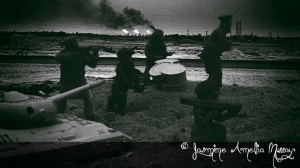
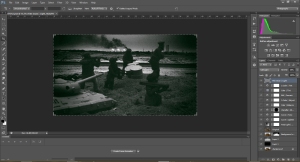 PA160747.ORF and Screengrab
PA160747.ORF and Screengrab
PA160747.ORF
1) Duplicate Layer> Layer Mask extracting from backdrop
2) Paste in exploding oil field layer underneath the layer mask layer-> Blur> Tilt-Shift
3) Area Light placed on lower right
4) Curve-> Lighten and Tone
5) Vignette reverse elliptical selection 15% opacity
6) Adjust colour ranges/hue/saturation/contrast
7) Black and White conversion
8) Tint selective colour- lighten red
9) Add Noise “Mock Film Grain” at 38% opacity
Depicts the group of jihadists from a different angle with a different explosion or oil field to imply that they are in a different location different members but with the same intent as the previous shot. Using a tilt-shift blur to the appropriated backdrop helps create the illusion that the scene going on behind them is on location and not added in post-processing, as well as seamlessly blending into the foreground sand. The usage of black and white, as an ongoing theme in these photographs is to pay homage to the saying that when things are ‘black and white’ it’s a clear choice between good vs evil, as well as black and white photography often considered as ‘pure’ unphotoshopped photography, people trust it more as it implicates the usage of film photography, or spy photography or footage captured by robotic drones. The composited backdrop helps bring the piece together adding an extra sense of depth to the insurgents in the sand. However I feel that the tank’s composition in this piece almost seems to narrate that the tank belongs to the anti-jihadist mission, and as such changes the meaning behind the piece.
Again like Hassan’s image I struggled to find a correctly attributed photograph, as my initial results brought up various blogging platforms, which entries did not state or credit who had taken the photograph. Several pages into my reverse image search I found the following URL of a New York Times article from 2008: http://www.nytimes.com/2008/06/19/world/middleeast/19iraq.html?pagewanted=all&_r=0 which lists the photograph as “Oil fields in the Iraqi province of Basra. Iraq produces about 2.5 million barrels of oil per day. – Moises Saman for The New York Times.” Whilst the scene at hand does not feature an explosion in an oil field it does reinforce the context of what the jihadists are doing with oil barrels.
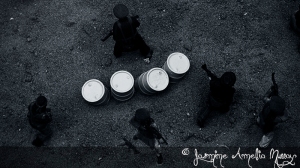
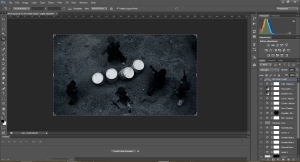 PA160013.ORF and Screengrab
PA160013.ORF and Screengrab
PA160013.ORF
1) Duplicate Layer > Layer Mask extracting from the backdrop
2) Adjust levels of gun, before paste- resize, then layer mask to remove the backdrop
3) Adjust levels of figure shot from above, before paste – resize, then layer mask to remove the backdrop and base of figure
4) Adjust Channel/Gradient Map> Curves, Hue, Saturation and Highpass low to adjust colour profile and exposure
5) Black and White conversion
6) Vignette reverse elliptical selection at 15% opacity
7) Hue, Desaturate and adjust Curves, Gradients to brighten and lighten
8) Area lighten in bottom right
9) Noise> Film grain at 20% opacity
Depicts a group of jihadists from above protecting their oil from all angles- to mimic what would be seen if footage was taken via a robotic drone from above, however I feel this composition highlights the fakery, in terms of quality and scale of the figures and oil drums vs the sand, without the use of appropriating a backdrop it takes away the context of air strikes and the location no longer being clear, even though the message that ISIS is attempting to ‘control’ the oil remains. The usage of black and white, as an ongoing theme in these photographs is to pay homage to the saying that when things are ‘black and white’ it’s a clear choice between good vs evil, as well as black and white photography often considered as ‘pure’ unphotoshopped photography, people trust it more as it implicates the usage of film photography, or spy photography or footage captured by robotic drones.
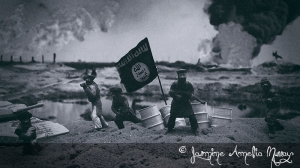
 PA160742.ORF and Screengrab
PA160742.ORF and Screengrab
PA160742.ORF
1) Duplicate layer > layer mask extracting from backdrop
2) Paste in exploding oil field layer underneath the layer mask layer – > Blur > Tilt-Shift
3) Paste, resize and layer mask plane and ISIS flag
4) Area Light placed in the Upper left
5) Curve -> Lighten tone
6) Vignette at 15% opacity using a reverse gradient elliptical selection
7) Adjust colour ranges and contrast
8) Black and White conversion
9) Tint light grey and soften the colour
10) Add Noise “Mock Film Grain” at 38% opacity
11) Smoke brushes on right cloud to lighten
The image below depicts the group of jihadists with a clearly labelled ISIS flag placed in the center of the group – with a blurred backdrop appropriated from the internet of an oil explosion. The flag is appropriated from the Independent article “ISIS ‘behead own fighters’ front headline image. The image also references to the 25th September “US Air Strikes are failing to slow ISIS says desperate Kurds”. The tilt-shift blur to the appropriated backdrop, helps create the illusion that the scene going on behind them is on location and not added in post-processing, as well as seamlessly blending into the foreground sand. The usage of black and white, as an ongoing theme in these photographs is to pay homage to the saying that when things are ‘black and white’ it’s a clear choice between good vs evil, as well as black and white photography often considered as ‘pure’ unphotoshopped photography, people trust it more as it implicates the usage of film photography, or spy photography or footage captured by robotic drones. The composited backdrop helps bring the piece together adding an extra sense of depth to the insurgents in the sand. However I feel the placement of the plane let’s down the composition in comparitive to the outcome of ‘PA160008’.
To attribute the original photographer for the background image, I had a lot of difficulty in finding this image correctly attributed, even via reverse image searching, however eventually through using google image search, I found the following URL: http://poleshift.ning.com/profiles/blogs/gas-explosion-kills-1-injures, which then gave a link to this URL: http://www.iraqoilreport.com/oil/production-exports/dead-missing-in-south-rumaila-station-blast-6201/which attributes the image as “Excess gas is flared at the Rumaila oil field in Basra, as workers look on. (ATEF HASSAN/Reuters)” and is apparently a shot from September 2011’s Iraq Rumaila oil field’s accidental explosion, yet could easily be a current photo of the US air strikes on oil fields in Iraq. However, a further search provided me with this URL: http://www.theguardian.com/business/2011/jul/31/bp-stranglehold-iraq-oilfield-contract which states the photograph as “Iraq’s Rumaila oilfield in 2009, the year BP and Chinese partner CNPC originally clinched a deal to develop the field. Photograph: Atef Hassan/Reuters” with no mention of the image depicting an oil explosion, so it is unclear whether or not the image just depicts the average day of working on an oil field. Unlike ‘PA110714’ the backdrop this time is slightly cropped into so the explosion borders the edges to mimic a different location to the initial shot, however I feel this actually hinders the image as this and the plane composition lack the effectiveness required.
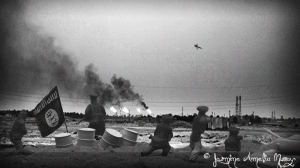
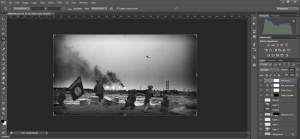 PA160008.ORF and Screengrab
PA160008.ORF and Screengrab
PA160008.ORF [2/2 Selected Final Images]
1) Duplicate layer > layer mask extracting from the backdrop
2) Paste in exploding oil field layer underneath the layer mask layer – > Blur > Tilt-Shift
3) Paste in ISIS flag (resize and extract with layer mask) and place on left 1/3 region and place under initial layer
4) Vignette at 20% opacity rectangular inverse rounded edges
5) Adjust curves-> Add contrast and lighten
6) Convert to Black and White conversion-> red levels
7) Add Noise “Mock Film Grain” at 38% opacity
8) Paste in plane below vignette layers but above initial layer-> layer mask to isolate- then rotate and shrink to scale
Depicts jihadists from a backwards angle with them surveying the devastation caused by the US air strikes on an oil field with the fighter plane flying off into the distance, whilst they are on guard the fact they aren’t facing the camera seems to change the emotive mood, from a bunch of angry militants to perhaps a group of people who no longer know what they are really fighting for- the appropriated flag hangs fairly limply, implying a slight breeze. References to “Bombs alone will not defeat an enemy that knows how to melt away” Independent 25th September, as well as the Daily Mail’s (24th September) “US air strikes to avert another 9/11”, The Guardian’s (September 27th) “We Must Beware- ISIS wants the west to wage a crusade” and the Daily Telegraph’s (25th September) “Bombing plays into the hands of Saudi-inspired militant jihadists” and “Obama asks world to unite behind his misson to blitz ISIL”. The tilt-shift blur to the appropriated backdrop, helps create the illusion that the scene going on behind them is on location and not added in post-processing, as well as seamlessly blending into the foreground sand. The usage of black and white, as an ongoing theme in these photographs is to pay homage to the saying that when things are ‘black and white’ it’s a clear choice between good vs evil, as well as black and white photography often considered as ‘pure’ unphotoshopped photography, people trust it more as it implicates the usage of film photography, or spy photography or footage captured by robotic drones. The composited backdrop helps bring the piece together adding an extra sense of depth to the insurgents in the sand. The composition is strong with the majority of the insurgents watching the fighter plane flying off from the explosion scene.
Like the Hassan image I struggled to find a correctly attributed photograph, as my initial results brought up various blogging platforms, which entries did not state or credit who had taken the photograph. Several pages into my reverse image search I found the following URL of a New York Times article from 2008: http://www.nytimes.com/2008/06/19/world/middleeast/19iraq.html?pagewanted=all&_r=0 which lists the photograph as “Oil fields in the Iraqi province of Basra. Iraq produces about 2.5 million barrels of oil per day. – Moises Saman for The New York Times.” Whilst the scene at hand does not feature an explosion in an oil field it does reinforce the context of what the jihadists are doing with oil barrels, the ‘intention’ or implication that they wish to control the oil supply in the Middle East.

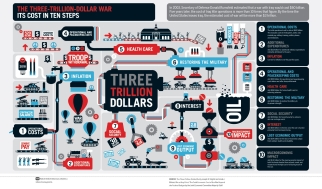


![Miniature Insurgents Lighting Diagram Miniature Insurgents [ISIS] Diorama [Olympus 60mm Macro 2.8] Flash@ 1/125 ISO200 F/22 [STILLS] Continuous@ 1/80 ISO1600 F/16 [Tablet Screen Backdrop]](https://jasmineameliamurrayphotography.files.wordpress.com/2014/09/lighting-diagram-1413904851-e1413904848453.png?w=285&h=300)
![Jihadist Bomber Portrait Lighting Diagram Flash@ 1/125 ISO200 F/22 [Stills] Continuous@ 1/80 ISO1600 F/16 [Video Footage]](https://jasmineameliamurrayphotography.files.wordpress.com/2014/09/lighting-diagram-1413903362-e1413903955286.png?w=300&h=232)
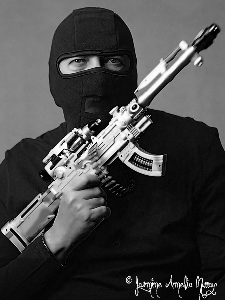
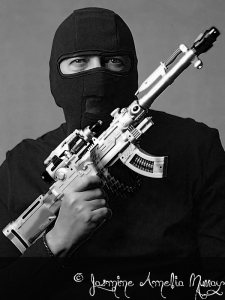
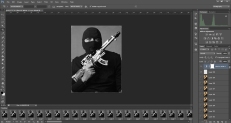


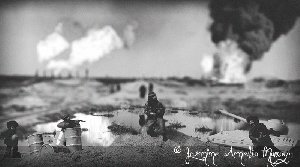
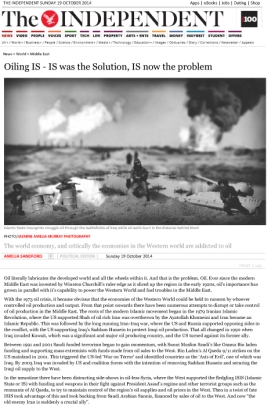
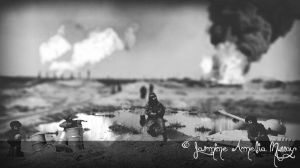
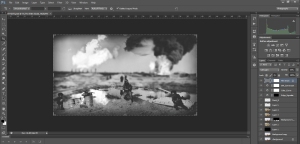
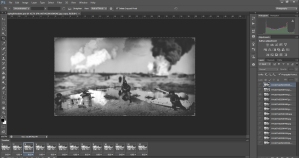
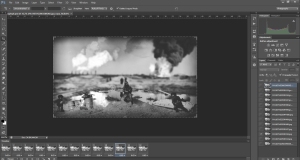







 PA160008.ORF and Screengrab
PA160008.ORF and Screengrab